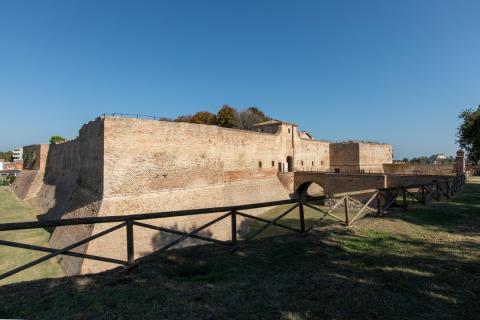It is difficult to pass through Fano without being struck by the monumental quadrangular fortress that stands near the city's port: imposing and majestic, the Rocca Malatestiana, built by Matteo Nuti at the behest of Sigismondo Pandolfo Malatesti, is one of the first fortresses built in the Marche in the 15th century and one of the symbolic places of the city.
Monumental and evocative, the Rocca Malatestiana or "Fortress" fits within the context of the Malatesta walls, still splendidly preserved for most of their original perimeter.
Already in use in the 14th century, it took on its current form at the behest of Sigismondo Pandolfo Malatesti, who most likely also took care of its design with the collaboration of the architect Matteo Nuti, in the great project of expansion and defensive strengthening of the city. The construction works began in 1438 and ended in 1452 with the erection of the Keep, an ideal outpost for coastal surveillance and, if necessary, also a lighthouse to guide the route of the ships that had their landing places right under the fortress. The construction then underwent adaptations and modifications, in relation to changing defensive needs and historical events, while maintaining the original appearance of a large fortified rectangle, delimited by steep curtains with robust corner towers.
Quadrangular in shape with towers at the sides, the fortress was built in two stages: initially the internal enclosure around the keep was built and at a later stage the external enclosure was expanded. The oldest part of the entire architectural complex is the Rocchetta, built on Roman and medieval remains. The fortress was accessed by two drawbridges, divided by the ravelin and the keep which was traditionally called the Malatestiana Tower. The escarpment was built with a considerable inclination so that the enemies could not escape the throwing stones and the projectiles thrown by the catapults bounced off at an angle.
The internal courtyard is surrounded by the wall supporting the upper walkways and the low building housing the chapel and the prison cells: originally this room of the fortress was terraced and was later raised by a floor and covered by a roof to house the stables , which were accessed via the characteristic ramp staircase. Underground, tunnels and secret passages connected the fortress with the city and the outside.
In 1463, following the damage caused by the siege of Federico di Montefeltro, Antonio da Sangallo carried out restoration work on the walls and built new towers, making the eastern tower almost a bastion and placing a cannon there. Used as a district prison since 1860, the fortress suffered heavy damage during the Second World War, only to be the subject of a long redevelopment project concluded in recent years. Today, the monumental fortress is accessible to the public and hosts events during the summer season. An underground network that is no longer practicable, made up of tunnels and secret passages that connected it with the city and the outside, represents the secret network of the Rock and its mysteries.
